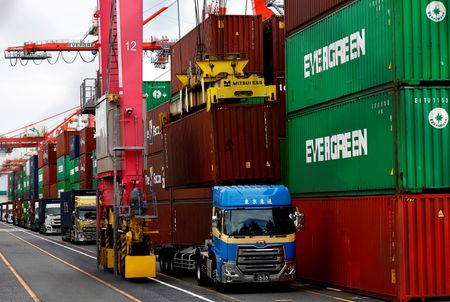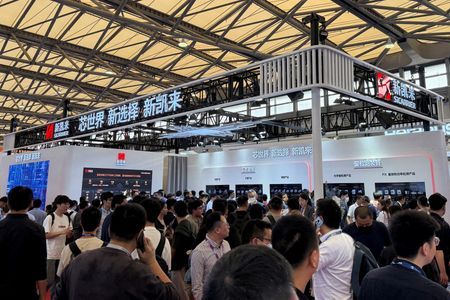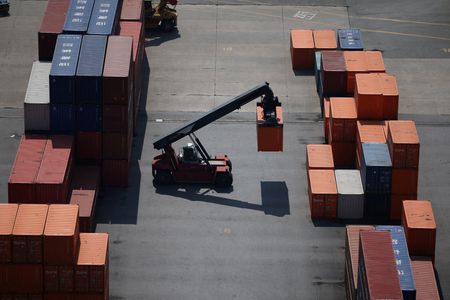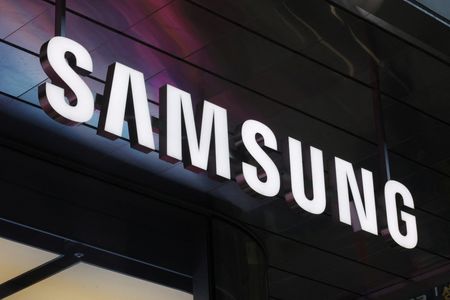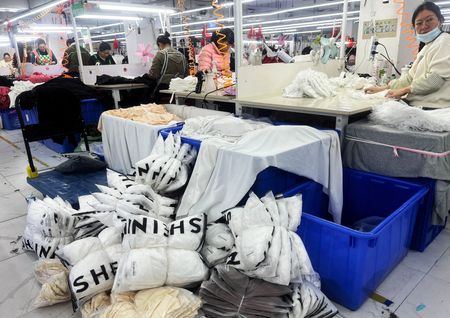By Jamie McGeever
ORLANDO, Florida (Reuters) – TRADING DAY
Making sense of the forces driving global markets
By Jamie McGeever, Markets Columnist
Risk assets extend gains
Stocks, oil and bond yields rose on Tuesday, lifted by the optimism surging through markets that the worst of the global trade crisis is past and that the growth outlook is much brighter than it looked only a few days ago.
In my column today I look at the market and economic chaos sparked by U.S. President Donald Trump’s ‘Liberation Day’ tariff announcement and ask: was it worth it? More on that below, but first, a roundup of the main market moves.
I’d love to hear from you, so please reach out to me with comments at jamie.mcgeever@thomsonreuters.com. You can also follow me at @ReutersJamie and @reutersjamie.bsky.social.
Trading Day is also sent by email every weekday morning. Think your friend or colleague should know about us? Forward this newsletter to them. They can also sign up here.
If you have more time to read, here are a few articles I recommend to help you make sense of what happened in markets today.
1. Trump’s tariff blitz yields deals but misses globaltrade fix 2. ‘Tariff Laffer Curve’ reins in trade agenda: Mike Dolan 3. ANALYSIS-US tariff pause on Beijing puts pressure on’China-plus-one’ countries 4. Forget Trump. A UK deal with the EU is what matters 5. INSIGHT-China’s AI-powered humanoid robots aim totransform manufacturing
Today’s Key Market Moves
* The S&P 500 and Nasdaq extend their rally, led by energyand tech. The S&P 500 is up 0.6%, the Nasdaq 1.6%. Weakness inhealthcare drags the Dow lower. * Germany’s DAX rises for a fourth day, edging back uptoward the previous day’s record high. It has now risen 13 outof the last 15 sessions. * Long-dated U.S. Treasury yields rise by up to 5 bps, withthe 10-year yield climbing back above 4.50% for the first timein a month. * Oil rises 2.5%, its fourth daily gain in a row. Brentand WTI futures have gained around 10% in those four days. * Sterling is the biggest gainer in G10 FX, rising 1% to$1.33 following hawkish comments from BoE chief economist HuwPill.
No ‘trade truce’ hangover, party continues
There was no hangover for world markets on Tuesday from the previous day’s trade-fueled euphoria. Indeed, the party continued as stocks and bond yields climbed higher, and volatility declined further.
The wave of relief that swept through world markets on Monday following the U.S.-China ‘trade truce’ was compounded on Tuesday by receding U.S. ‘stagflation’ fears after April inflation figures came in softer than economists had expected.
Consumer prices rose at a 2.3% annual pace in April, the smallest gain since February 2021 and a sign that the Federal Reserve is still well-placed to deliver gradual interest rate cuts later in the year.
The medium-term outlook for markets is still unclear. Uncertainty surrounding the path for tariffs, growth, and inflation this year is still high.
But that’s for another day. The last 48 hours have given some powerful rocket fuel for risk assets – a surprisingly rapid de-escalation in U.S.-Sino trade tensions, waves of upward revisions to Chinese and U.S. growth forecasts, and now the tamest U.S. inflation in over four years.
The global inflation picture was also burnished on Tuesday by figures from India that showed consumer prices in the world’s fifth-largest economy rose last month at the slowest pace in nearly six years.
Of course, these are backward-looking numbers and tariff-affected inflation rates in the coming months will likely be higher. But they’re still positive for risk appetite, and investors are willing to look on them favorably for now.
Optimism on trade is running high. In Saudi Arabia on Tuesday, U.S. President Donald Trump secured a $600 billion commitment from the oil powerhouse to invest in the United States; a number of U.S. technology firms, including Nvidia and Advanced Micro Devices, announced artificial intelligence deals in the Middle East; and China has removed a ban on airlines taking delivery of Boeing planes.
Sentiment toward China continues to improve, with several economists revising up their growth forecasts since the U.S.-Sino trade truce. On Tuesday, the yuan appreciated to its strongest level against the dollar since mid-November on the onshore and offshore spot markets.
What was the point of April’s market chaos?
The fog of uncertainty created by U.S. President Donald Trump’s trade war is suddenly lifting, although doubts over its longer-term economic impact will linger. As will another question: What was the point of all that ‘Liberation Day’ chaos and confusion?
Trump, a consistent advocate of tariffs since the 1980s, made it very clear during his election campaign that he intended to significantly raise import levies. As the self-styled ‘Tariff Man,’ he vehemently argued that tariffs will help raise federal revenues, revitalize U.S. manufacturing, and reduce the country’s yawning trade deficit.
One can argue the economic merits of his agenda, but no one, in good faith, can express surprise that he did exactly what he said he would do. But even some of Trump’s ardent backers are questioning the strategy and implementation.
Was the aim to whip up economic and market chaos to gain maximum leverage over America’s trading partners and thereby secure the most favorable terms for Washington in subsequent trade talks?
Maybe. Short-term havoc was certainly wreaked, with some $6 trillion wiped off the value of U.S. stocks in the three days after ‘Liberation Day.’ But now deals are getting done and all those losses have been erased – except, of course, for investors who got spooked and sold.
But after all that, it’s unclear whether the tariffs that will result from these deals – which will likely be much lower than the extreme figures put forward a few weeks ago – will be significant enough to move the dial meaningfully on the U.S. trade deficit.
And on the fiscal side, all tariffs announced so far this year are forecast to raise $2.7 trillion in federal revenue over the 2026-35 decade, up from an estimated $2.4 trillion before the U.S.-China ‘truce’ in Geneva, according to Yale Budget Lab, which pointed out that sky-high tariffs were far from ‘revenue optimal.’ Was the turbulence of the last several weeks worth an extra $30 billion a year, or 0.1% of GDP?
Of course, $2.7 trillion is not to be sniffed at, but it comes at a cost. Yale Budget Lab also estimates tariffs will knock 0.7 percentage points off real U.S. GDP growth this year, and in the long run the U.S. economy will permanently be 0.4 percentage points smaller. The price level of goods across the country will be permanently higher too, economists reckon.
Estimates vary, but the general view is that the global average effective tariff rate will be somewhere in the 13-18% range, down 10 percentage points from before the weekend truce but still the highest since before World War Two, and significantly higher than 2.3% at the end of last year.
Meanwhile, U.S. consumer and business confidence has slumped to some of the lowest levels on record, and consumer inflation expectations are the highest in decades. These indicators may improve in the months ahead, but much spending and investment has been put on hold due to the uncertainty and likely won’t be switched back on so quickly.
LASTING DAMAGE
Perhaps most importantly, the damage done to U.S. credibility hasn’t vanished simply because asset prices have rebounded.
Remember the methodology behind the Liberation Day figures, which saw some of the highest duties slapped on the world’s poorest countries and tariffs imposed on frozen islands largely inhabited by penguins? This was widely ridiculed and called into question the seriousness of Trump’s team, as have many of the other unorthodox policies the administration has been pursuing.
Faith in America as a reliable partner has clearly been diminished. As HSBC currency analysts reminded readers on Tuesday, “Trust takes years to build, seconds to break and forever to remake.”
The administration appears to be trying to repair some of that reputational damage. It’s notable that Treasury Secretary Scott Bessent and Trade Representative Jamieson Greer led the delegation in Geneva this weekend rather than tariff hardliners like Commerce Secretary Howard Lutnick and Office of Trade and Manufacturing Policy director Peter Navarro.
But fully restoring U.S. credibility won’t be a quick fix. And the long-term consequences for U.S. rates, the dollar and U.S. assets overall could be meaningful.
So if we consider where we are relative to a no-tariff scenario, U.S. growth will likely be slower, prices will likely be higher, and uncertainty will run much deeper. But would these costs be so burdensome had the administration taken a more pragmatic, less confrontational approach from the start?
The wounds will heal, but the scars may last a long time.
What could move markets tomorrow?
* India wholesale price inflation (April) * Germany CPI inflation (April, final) * Bank of England Deputy Governor Sarah Breeden speaks * Federal Reserve Vice Chair Philip Jefferson speaks
Opinions expressed are those of the author. They do not reflect the views of Reuters News, which, under the Trust Principles, is committed to integrity, independence, and freedom from bias.
(By Jamie McGeever)


